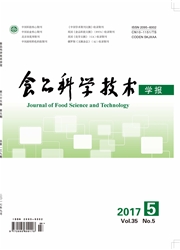

 中文摘要:
中文摘要:
为解决“普通花生品种过多和原料过剩、专用加工品种和原料缺乏”的问题,本研究对26个品种花生的感官特性、理化与营养特性、加工特性与其花生酱品质之间的关系进行研究,建立原料特性与花生酱品质间的关系模型。以26个品种花生制备的花生酱为原料,分析各品种花生特性与花生酱品质间的关系,采用20个品种的原料特性数据构建评价模型,另外6个品种品质数据进行验证。结果显示,花生原料的百仁重、粗蛋白、粗脂肪、总维生素E、油酸/亚油酸等5个指标与花生酱品质在0.05水平上关系显著,采用统计学分析建立花生酱用花生原料特性评价模型,验证模型的尺。为0.788。研究结果表明,花生的原料特性显著影响花生酱品质,粗蛋白、总维生素E与油酸/亚油酸等指标的含量越高,花生酱品质越好。该方法可为不同花生品种的加工利用和专用品种的选择提供依据。
 英文摘要:
英文摘要:
In order to solve the adverse situation, which ordinary peanut varieties and ingredients are lack and special processing varieties and ingredients are surplus. This paper mainly discussed the relationship between peanut quality ( sensory quality, physicochemical quality and processing quality) and peanut butter, and to establish the relationship model between peanut material characteristics and peanut butter quality. 26 peanut varieties were used to prepare the peanut butter, and the relationship between the characteristics of peanut and peanut butter was analyzed. 20 varieties were assigned to the calibration set, whereas the remaining 6 varieties constituted the validation set. The results showed that the characteristics of different peanuts varieties and its preparation peanut butter had significantly difference. Hundred ker- nel weight, the content of protein and fat, the total vitamin content and O/L ratio had significant relation- ships with peanut butter (P 〈 0.05 ). The model of statistical analysis was acceptable (R2 = 0. 788 ). The content of protein, the total vitamin content and O/L ratio were positively correlated with peanut but- ter quality. The model of peanut quality can be used to predict the peanut butter quality of unknown vari- eties. It can also provide a basis for processing and utilization of different peanut varieties and selection of special varieties.
 同期刊论文项目
同期刊论文项目
 同项目期刊论文
同项目期刊论文
 期刊信息
期刊信息
